3. Cryoshperic modelResults Page | Top Page |
|||||||||||||||||||||||||||
|
The organization in charge: Earth frontier research system
a. SummaryIn order to investigate the influence of the response characteristic and sea level on the ice sheet to warming, the ice sheet model was developed so that reality might often be expressed, and the adaptability to Greenland and the South Pole was investigated (Saito and Abe-Ouchi, 2004). Furthermore, dissolution of the ice sheet equivalent to about 3m of sea levels taking place, if the climate of the Greenland area carries out warming 3-4 times, and climate carrying out warming of the South Pole area 7-8 times or more, and bringing about the sea level rise by dissolution of an ice sheet at last was shown. On the other hand, in order to investigate about the grade of prediction of warming, the adjustment and the sensitivity experiment of an air sea sea ice joint model (resolution is a degree, 200km of atmospheres, and about 100km of oceans in the middle) which do not have artificial flux regulation using an Earth Simulator were conducted. As a result of investigating the response characteristic over the reproducibility and warming of the climate of high latitude with high warming sensitivity, or sea ice [ all balls / especially ], even if greenhouse gas stabilizes the grade of warming of the Greenland ice sheet circumference at the end time of the 21st century, the grade which affects a sea level intentionally is reached. The amount of increases in the carbon dioxide in the atmosphere assumed that it was an annual rate of 1%, and prediction until after [ which reaches 4 times ] 140 years was performed. Compared with all balls, the increase in temperature is large in polar, especially the Northern Hemisphere, and the Greenland ice sheet serves as a grade which influences a sea level intentionally. A result which the increase in precipitation exceeds a little from the effect of the increase in temperature in the South Pole ice sheet was brought. From now on, the same experiment will be conducted by the version from which the indefinite parameter of a model and sensitivity differ. The more detailed analysis of polar, such as tens of year change and width of uncertainty, is required. Furthermore, the program alteration for enabling calculation of air - ice sheet combination (partial integrated model) which synchronized is recommended, and the present adjustment is continued. b. Research purposeAn ice sheet is ashore, there is sea ice in earth top north-south two poles at sea, and those generation change is directly linked with the climate change of an earth scale. For this reason, in connection with warming, an ice sheet and sea ice react sensitively, and we dissolve, or are anxious about affecting still wide range climate and sea surface change. So, into this group, the atmosphere / ocean / sea ice / ice sheet joint model which finally works on an Earth Simulator are built, and the prediction experiment of global warming or sea surface change is conducted. First, it strives for grasp of an indefinite element through various sensitivity experiments, improving a partial model. Furthermore, it aims at raising the accuracy of a prediction experiment, conducting the reappearance experiment of the present or the past using the combined model. Moreover, since the past climate and the restoration of ice sheet change / sea level by the data of a seabed sediment or geographical feature have come to be considerably performed with high precision about the last glacial epoch or subsequent ones 20,000 years ago, the model is verified through trying the numerical simulation reproducing this. c. A research program, a method, a scheduleAbout the ice sheet, manufacture of a partial model was briefly performed by FY 2002, and the response characteristic has been investigated. In FY 2003, improved each portion or the parallelization optimization of the ice sheet model program was carried out for Earth Simulators, and the coupling agent was developed and the characteristic of combination of a climate model and an ice sheet dynamics model was investigated. The ice sheet in FY 2004 performs combination with an air model. Moreover, the warming experiment was conducted using the air sea joint model of the resolution of a degree in the middle, and the influence on sea ice or an ice sheet was considered in FY 2003. From now on, combination of an ice sheet model and an air model is recommended, and warming influence is discussed quantitatively. d. The research program in FY 2003In the current fiscal year, development of the partial integrated model of an air - ice sheet is started. The partial integrated model using an easy air model is that (Omori, 2003) successful which was performed in a tentative way, and adds the change for combining an ice sheet model with the coupling agent of a general circulation model (MIROC) based on this experience. Moreover, the parallelization optimization of the ice sheet model program is carried out for Earth Simulators, or a coupling agent is developed and the characteristic of combination of a climate model and an ice sheet dynamics model is investigated. It is with an air oceanic circulation model, and a warming experiment is conducted, and the response to warming in the chill area appears how over a long period of time, or it is with the model in this time, and an experiment is tried. e. Reports in FY 2003e.1. The response characteristic of the ice sheet model to warmingIt investigated [ response characteristic / of the ice sheet model to warming ] about Greenland and the South Pole ice sheet. The time scale of change of the ice sheet in warming will reach from 100 years in 1000. According to ice sheet model independent calculation, about 8 times warming is required on about 2 times warming and the South Pole ice sheet on the Greenland ice sheet to contribute to the increase in a sea level by 2m. Since joint processes other than an advanced effect (Albedo feedback and precipitation change) are not taken into consideration this time, direct coupling is needed.
Fig. 40: Steady state response to warming of Greenland ice sheet. (a) the time of the present altitude and one (b) temperature rise (equivalent to 1m of rises in the sea level) -- two (c) temperature rise (about 2m), three (d) temperature rise (about 3m), and four (e) temperature rise (about 6m). However, cautions are required for not taking temperature albedo feedback into consideration and being a steady state response, and it is due to take into consideration about this in FY 2004.
Fig. 41: Steady state response to warming of South Pole ice sheet. (a) Cautions are required for not taking into consideration ten (c) temperature rise (about 11m), 15 (d) temperature rise (about 30m), however temperature albedo feedback and being a steady state response, and it is due to take into consideration at the time of the present altitude and seven (b) temperature rise (equivalent to 1m of rises in the sea level) too about this in FY 2004. The air sea joint model (the atmosphere T42, 20 layers, and the ocean are about 1 time and 40 layers from latitude longitude 0.5) of inside resolution was adjusted, and the response characteristic was investigated. Adjustment was repeated [ whether it can be managed even if it does not carry out flux regulation used conventionally, and ]. Consequently, it came to obtain the good result which can be said to be that there is almost no drift of temperature or a sea level. The warming experiment (climate response to the increase in CO2 annual rate of 1%) using an air sea joint model (MIROC3.1) was performed in a tentative way. Although partial movement and weakening of depths circulation sinking place were seen with warming, warming around Greenland is not barred greatly. Furthermore, although examination is required in detail, a bearing report is carried out in part here.
Fig. 42: Response of temperature over increase in (a) CO2 annual rate of 1% (green line). This was compared with the standard experiment (they are fixation and a red line at the CO2 present level), and CO2 level (180 ppm) experiment (blue line) of glaciation. (b) Time change of the North Atlantic Ocean meridional circulation intensity (NADW) is but shown like (a).
Fig. 43: When CO2 increases from 1990 at a rate of an annual rate of 1% (CO2 will reach twice in 2060 and will reach 4 times in 2130), change of the temperature of each summer of all ball annual mean temperature, the South Pole, and Greenland is shown.
Fig. 44: Temperature rise distribution and precipitation change distribution at CO2x4 time (the 140th year). In Greenland and the South Pole, warming and a precipitation rise are seen and there is an effect of rivaling in ice sheet volume change.
Fig. 45: Response to reappearance and warming of Atlantic Ocean meridional circulation. The integration 400 year state of 1 (left) and x4 times (right) many CO2x [ as this ] level.
Fig. 46: Sea ice (a February blue, an August green, and the isoline 0 of closeness, 0.3, 0.9), and convection position (many [ the convection frequency in annual 500m depth, and red degree ]). Left sequences are CO 2x1 and the right sequence CO 2x4. In CO2x4, the sea ice of summer remains in winter, although two poles are lost. Development with the ice sheet model and joint model which were started in the current fiscal year formed the following plans, and has recommended the present program development.
f. ConsiderationThe climate and the snow ice distribution characteristics in high latitude, such as warming change, were decided by the interaction of air - sea - snow ice. Although the sea ice model was already incorporated into the air sea joint model, since the tool to consider was created, it is a future subject to investigate the response characteristic of the climate of a high latitude region by the further numerical simulation and the further sensitivity experiment. Since it turned out that the interaction of sea ice and ocean circulation (convection) has big influence on climate especially in the Greenland region and the South Pole region where an ice sheet exists, it will pull from now on, continues and investigates in detail. Since the influence which affects a convection is also considered and dissolve water needs to repeat examination from now on again through creation of the partial integrated model of the ice sheet - air - ocean by dissolution of the ice sheet at the time of warming, I want to put emphasis on combination of an ice sheet and the atmosphere in FY 2004.g. Bibliographyh. The announcement of a result<Paper announcement>Ogura, T., A. Abe-Ouchi and H. Hasumi (2004) Effects of sea ice dynamics on the Antarctic sea ice distribution in a coupled ocean atmosphere model. Journal of Geophysical Res. in press. Saito, F., A. Abe-Ouchi and H. Blatter (2003) Effects of first order stress gradients in an ice sheet evaluated by a three-dimensional thermomechanical coupled model. Annals of Glaciology, 37, 166-172 Saito, F. and A. Abe-Ouchi (2004) Thermal Structure of Dome Fuji and East Queen Maud Land, Antarctica, simulated by a three-dimensional ice sheet model. Annals of Glaciology, 38, in press. Schneeberger, C., H. Blatter, A. Abe-Ouchi and M. Wild (2003) Modelling Changes in the Mass Balance of Glaciers of the Northern Hemisphere for a transient 2xCO2 scenario. Journal of Hydrology, 282, (1-4) 145-163. Press reports It publishes in the 18th page of a morning paper on Asahi Shimbun February 8, 2004. Next Page (4. climate physics core model improvement) |
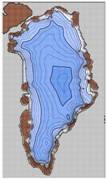
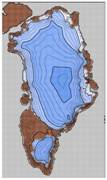
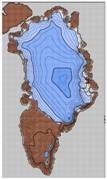
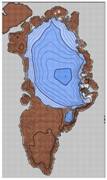
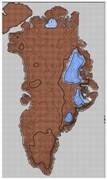
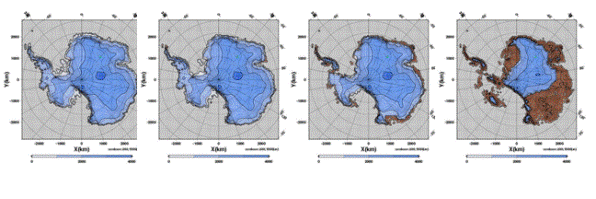
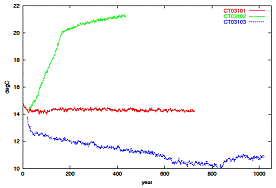
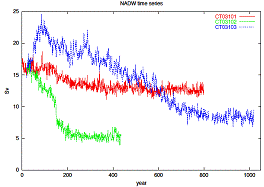

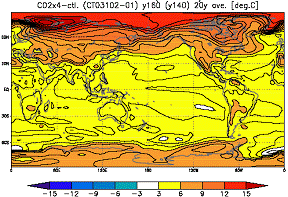

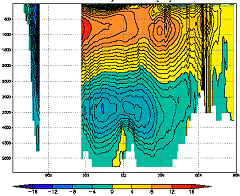
![Fig. 45: Response to reappearance and warming of Atlantic Ocean meridional circulation.The integration 400 year state of a 4 times many CO<sub>2<sub>x [ as this / /] level.](./figure/3-13.gif)
![Fig. 46: Sea ice (a February blue, an August green, and the isoline 0 of closeness, 0.3, 0.9), and convection position (many [ the convection frequency in the annual 500m depth and red degree ])](./figure/3-14.gif)
![Fig. 46: Sea ice (a February blue, an August green, and the isoline 0 of closeness, 0.3, 0.9), and convection position (many [ the convection frequency in the annual 500m depth and red degree ])](./figure/3-15.gif)
![Fig. 46: Sea ice (a February blue, an August green, and the isoline 0 of closeness, 0.3, 0.9), and convection position (many [ the convection frequency in the annual 500m depth and red degree ])](./figure/3-16.gif)
![Fig. 46: Sea ice (a February blue, an August green, and the isoline 0 of closeness, 0.3, 0.9), and convection position (many [ the convection frequency in the annual 500m depth and red degree ])](./figure/3-17.gif)
